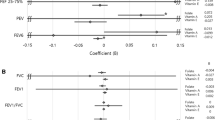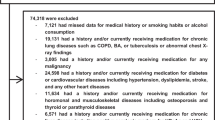Abstract
Background:
Increased dietary intake of antioxidants has been associated with higher lung function, but few studies have used biological markers of antioxidant intake.
Objective:
This study aimed to determine if antioxidant status, as measured by blood levels, influences lung function.
Design:
Using a random subsample of 479 participants, aged 18–65 y old, from a larger cross-sectional observational study, the association of forced expiratory volume in 1 s (FEV1) with plasma copper, vitamin C, vitamin E and serum selenium was assessed.
Results:
An s.d. increase in blood copper level was associated with a difference in FEV1 of −48 ml (95% confidence intervals: −95, −2 ml, P=0.04), vitamin C +49 ml (+4, +94, P=0.03), vitamin E −15 ml (−62, +32, P=0.53) and selenium +52 ml (+7, +96, P=0.02). The sizes of association were not appreciably altered in a mutually adjusted model.
Conclusions:
Higher levels of serum vitamin C and selenium appear to be associated with higher FEV1. The association between higher serum copper and lower FEV1 requires further study in view of the ubiquitous exposure to this mineral.
Sponsorship:
National Asthma Campaign and British Lung Foundation.
This is a preview of subscription content, access via your institution
Access options
Subscribe to this journal
Receive 12 print issues and online access
$259.00 per year
only $21.58 per issue
Buy this article
- Purchase on Springer Link
- Instant access to full article PDF
Prices may be subject to local taxes which are calculated during checkout

Similar content being viewed by others
References
Al-Timimi D & Dormandy T (1977): The inhibition of lipid autoxidation by human caeruloplasmin. J. Biochem. 168, 283–288.
Barnes P (2000): Chronic obstructive pulmonary disease. N. Engl. J. Med. 343, 269–280.
Bierenbaum M, Fleischman A, Dunn J, Hayton T, Pattison D & Watson P (1973): Serum parameters in hard and soft communities. Am. J. Pub. Health 63, 169–173.
Bieri J, Tolliver T & Catignani G (1979): Simultaneous determination of alpha-tocopherol and retinol in plasma or red cells by high pressure liquid chromatography. Am. J. Clin. Nutr. 32, 2143–2149.
Boosalis M, Snowdon D, Tully C & Gross M (1996): Acute phase response and plasma carotenoid concentrations in older women: findings from the Nun study. Nutrition 12, 475–478.
Britton J, Pavord I, Richards K, Knox A, Wisniewski A, Lewis S, Tattersfield AE & Weiss S (1995): Dietary antioxidant vitamin intake and lung function in the general population. Am. J. Respir. Crit. Care Med. 151, 1383–1387.
Britton J, Pavord I, Richards K, Knox A, Wisniewski A, Weiss S & Tattersfield AE (1994a): Dietary sodium intake and the risk of airway reactivity in a random adult population. Thorax 49, 875–880.
Britton J, Pavord I, Richards K, Wisniewski A, Knox A, Lewis S, Tattersfield AE & Weiss S (1994b): Dietary magnesium, lung function, wheezing, and airway hyper-reactivity in a random adult population sample. Lancet 344, 357–362.
Burtis C & Ashwood E (1986): Tietzbook of Clinical Chemistry, 2nd Edition. London: WB Saunders.
Butland B, Fehily A & Elwood P (2000): Diet, lung function, and lung function decline in a cohort of 2512 middle aged men. Thorax 55, 102–108.
Chen R, Tunstall-Pedoe H, Bolton-Smith C, Hannah M & Morrison C (2001): Association of dietary antioxidants and waist circumference with pulmonary function and airway obstruction. Am. J. Epidemiol. 153, 157–163.
Denko C (1979): Protective role of ceruloplasmin in inflammation. Agents Actions 9, 333–334.
Dow L, Tracy M, Villar A, Coggon D, Margetts B, Campbell M & Holgate S (1996): Does dietary intake of vitamins C and E influence lung function in older people. Am. J. Respir. Crit. Care Med. 154, 1401–1404.
Fletcher C, Peto R, Tinker C & Speizer F (eds) (1976): Factors related to the development of airflow obstruction. In The Natural History of Chronic Bronchitis and Emphysema pp 70–102. Oxford: Oxford University Press.
Fogarty A, Lewis S, Weiss S & Britton J (2000): Dietary vitamin E, immunoglobulin E levels and atopy. Lancet 356, 1573–1574.
Forsberg L, de Faire U & Morgenstern R (2001): Oxidative stress, human genetic variation, and disease. Arch. Biochem. Biophys. 389, 84–93.
Fridovich I (1978): The superoxide radical is an agent of oxygen toxicity: superoxide dismutases provide an important defense. Science 201, 875–880.
Gilliland F, Berhane K, Li Y-F, Gauderman W, McConnell R & Peters J (2003): Children's lung function and antioxidant vitamin, fruit, juice, and vegetable intake. Am. J. Epidemiol. 158, 576–584.
Goldstein I, Kaplan H, Edelson H & Weissman G (1979): Ceruloplasmin: a savenger of superoxide anion radicals. J. Biolog. Chem. 254, 4040–4045.
Grievink L, Smit H, Ocke M, Van't Veer P & Kromhout D (1998): Dietary intake of antioxidant (pro)-vitamins respiratory symptoms and pulmonary function: the MORGEN study. Thorax 53, 166–171.
Grievink L, Smit H, Veer P, Brunekreef B & Kromhout D (1999): Plasma concentrations of the antioxidants b-carotene and a-tocopherol in relation to lung function. Eur. J. Clin. Nutr. 52, 813–817.
Grievink L, Waart F, Schouten E & Kok F (2000): Serum carotenoids, a-tocopherol, and lung function among Dutch elderly. Am. J. Respir. Crit. Care Med. 161, 790–795.
Gutteridge J, Richmond R & Halliwell B (1980): Oxygen free-radicals and lipid peroxidation: inhibition be the protein caeruloplasmin. FEBS Lett. 112, 269–272.
Halliwell B (1996): Antioxidants in human health and disease. Ann. Rev. Nutr. 16, 33–50.
Halliwell B & Gutteridge J (1984): Oxygen toxicity, oxygen radicals, transition metals and disease. Biochem. J. 219, 1–14.
Hu G & Cassano P (2000): Antioxidant Nutrients and Pulmonary Function: The Third National Health and Nutrition Examination Survey (NHANES III). Am. J. Epidem. 151, 975–981.
Hu G, Zhang X, Chen J, Peto R, Campbell C & Cassano P (1998): Dietary vitamin C intake and lung function in rural china. Am. J. Epidemiol. 148, 594–599.
Hunter D (1990): Biochemical indicators of dietary intake. In Nutritional Epidemiology ed. W Willett, pp 143–216. New York: Oxford University Press.
Kadrabova J, Madaric A, Podivinsky F, Gazdik F & Ginter E (1996): Plasma zinc, copper and copper/zinc ration in intrinsic asthma. J. Trace Elements Med. Biol. 10, 50–53.
Kelly Y, Sacker A & Marmot M (2003): Nutrition and respiratory health in adults: findings from the Health Survey for Scotland. Eur. Resp. J. 21, 664–671.
Kennedy T, Ghio A, Reed W, Samet J, Zagorski J, Quay J, Carter J, Dailey L, Hoidal J & Devlin R (1998): Copper-dependent inflammation and nuclear factor-kB activation by particulate air pollution. Am. J. Respir. Cell. Mol. Biol. 19, 366–378.
Lange P, Parner J, Vestbo J, Schnohr P & Jensen G (1998): A 15 year follow-up study of ventilatory fucntion in adults with asthma. N. Engl. J. Med. 339, 1194–1200.
Lawlor D, Davey Smith G, Bruckdorfer K, Kundu D & Ebrahim S (2004): Those confounded vitamins: what can we learn from the differences between observational versus randomised trial evidence? Lancet 363, 1724–1727.
Malvy J-M, Lebranchu Y, Richard M-J, Arnaud J & Favier A (1993): Oxidative metabolism and severe asthma in children. Clin. Chim. Acta. 218, 117–120.
Maritz G & Windvogel S (2003): Is maternal copper supplementation during alveolarisation protecting the developing rat lung against the adverse effects of maternal nitotine exposure? A morphometric study. Exp. Lung Res. 29, 243–260.
Ness A, Khaw K, Bingham S & Day N (1996): Vitamin C status and respiratory function. Eur. J. Clin. Nutr. 50, 573–579.
O'Dell B, Kilburn K, McKensie W & Thurston R (1978): The lung of the copper-deficient rat. Am. J. Pathol. 91, 413–432.
Repine J, Bast A, Lankhorst I & and the oxidative stress study group (1997): Oxidative stress in chronic obstructive pulmonary disease. Am. J. Respir. Crit. Care Med. 156, 341–357.
Rice T, Clarke R, Godleski J, Al-Mutairi E, Jiang N-F, Hauser R & Paulaukis J (2001): Differential ability of transition metals to induce pulmonary inflammation. Toxicol. Appl. Pharm. 177, 46–53.
Schunemann H, Grant B, Freudenheim J, Muti P, Browne R, Drake J, Klocke R & Trevisan M (2001): The relation of serum levels of antioxidant vitamins C and E, retinol and carotenoids with pulmonary function in the general population. Am. J. Respir. Crit. Care Med. 163, 1246–1255.
Schwartz J & Weiss S (1990): Dietary factors and their relation to respiratory symptoms. The second national health and nutrition examination survey. Am. J. Epidemiol. 132, 67–76.
Schwartz J & Weiss S (1994): Relationship between dietary vitamin C and pulmonary function in the First National Health and Nutrition Examination Survey (NHANES I). Am. J. Clin. Nutr. 59, 110–114.
Sparrow D, Silbert J & Weiss S (1982): The relationship of pulmonary function to copper concentrations in drinking water. Am. Rev. Respir. Dis. 126, 312–315.
Taylor J & Oey L (1982): Ceruloplasmin: plasma inhibitor of the oxidative inactivation of alpha1-protease inhibitor. Am. Rev. Respir. Dis. 126, 476–482.
Traber M & Jialal I (2000): Measurement of lipid-soluble vitamins—further adjustment needed? Lancet 355, 2013–2014.
Varley H, Gowenlock A & Bell M (1980): Practical Clinical Biochemistry, 5th Edition. London and Tonbridge: The Whitefriars Press, 941–946.
Vural H, Uzun K, Uz E, Kocyigit A, Cigli A & Akyol O (2000): Concentrations of copper, zinc, and various elements in serum of patients with bronchial asthma. J. Trace Elements Med. Biol. 14, 88–91.
Acknowledgements
The study was funded by the British Lung Foundation and the National Asthma Campaign.
Author information
Authors and Affiliations
Corresponding author
Additional information
Guarantor: A Fogarty.
Contributors: JB, IP and SW designed the study. Data collection was by JB and IP. Data analysis was by AF, SL and PP. All authors contributed to the preparation of the manuscript. The authors have no personal interests in the organisations that funded the research.
Rights and permissions
About this article
Cite this article
Pearson, P., Britton, J., McKeever, T. et al. Lung function and blood levels of copper, selenium, vitamin C and vitamin E in the general population. Eur J Clin Nutr 59, 1043–1048 (2005). https://doi.org/10.1038/sj.ejcn.1602209
Received:
Revised:
Accepted:
Published:
Issue Date:
DOI: https://doi.org/10.1038/sj.ejcn.1602209
Keywords
This article is cited by
-
Assessment of trace elements, systemic inflammation, and electrolytes in patients with chronic obstructive pulmonary disease
The Egyptian Journal of Bronchology (2023)
-
Evaluation of Serum Trace Element Levels and Biochemical Parameters of COVID-19 Patients According to Disease Severity
Biological Trace Element Research (2022)
-
A Review on the Serum Electrolytes and Trace Elements Role in the Pathophysiology of COVID-19
Biological Trace Element Research (2021)
-
The effects of antioxidant vitamin supplementation on expiratory flow rates at rest and during exercise
European Journal of Applied Physiology (2015)
-
Clinical and echocardiographic correlates of serum copper and zinc in acute and chronic heart failure
Clinical Research in Cardiology (2014)



